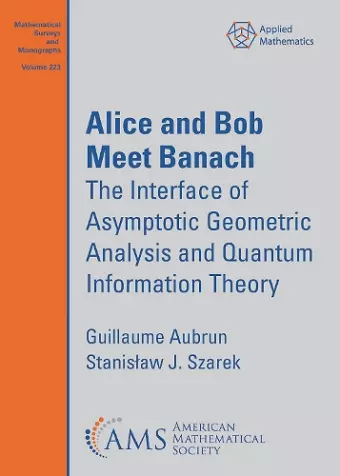Alice and Bob Meet Banach
The Interface of Asymptotic Geometric Analysis and Quantum Information Theory
Guillaume Aubrun author Stanislaw J Szarek author
Format:Paperback
Publisher:American Mathematical Society
Published:31st Oct '17
Currently unavailable, our supplier has not provided us a restock date

The quest to build a quantum computer is arguably one of the major scientific and technological challenges of the twenty-first century, and quantum information theory (QIT) provides the mathematical framework for that quest. Over the last dozen or so years, it has become clear that quantum information theory is closely linked to geometric functional analysis (Banach space theory, operator spaces, high-dimensional probability), a field also known as asymptotic geometric analysis (AGA). In a nutshell, asymptotic geometric analysis investigates quantitative properties of convex sets, or other geometric structures, and their approximate symmetries as the dimension becomes large. This makes it especially relevant to quantum theory, where systems consisting of just a few particles naturally lead to models whose dimension is in the thousands, or even in the billions.
Alice and Bob Meet Banach is aimed at multiple audiences connected through their interest in the interface of QIT and AGA: at quantum information researchers who want to learn AGA or apply its tools; at mathematicians interested in learning QIT, or at least the part of QIT that is relevant to functional analysis/convex geometry/random matrix theory and related areas; and at beginning researchers in either field. Moreover, this user-friendly book contains numerous tables and explicit estimates, with reasonable constants when possible, which make it a useful reference even for established mathematicians generally familiar with the subject.
“[This book] will be an invaluable reference to scientists working on the more mathematical aspects of quantum information theory.” - Mary Beth Ruskai, Zentralblatt MATH
“A wide variety of audiences would be interested in this book: Parts II or III would be suitable for a graduate course on QIT from the perspective of functional analysis, convex geometry, or random matrix theory, or on the applications of AGA. With a mix of classical and recent results, as well as the concise treatment of the subject areas, the book could be used as a reference book for researchers working in this area. Furthermore, the large number of exercises, with an appendix of hints, would make it suitable for an independent study.” - Sarah Plosker, Mathematical Reviews
ISBN: 9781470477967
Dimensions: unknown
Weight: unknown
414 pages